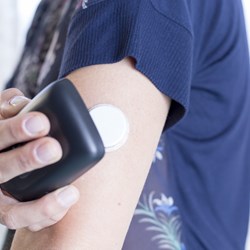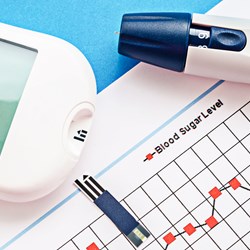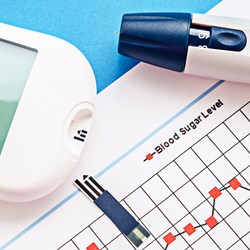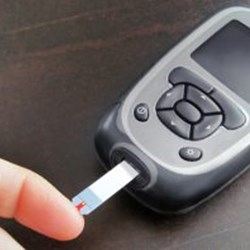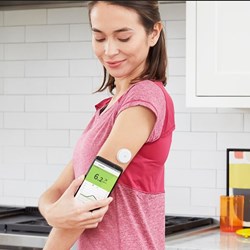Monitoring Diabetes
Not everyone with diabetes needs to monitor their blood glucose levels at home, but it is usually recommended for those using insulin, other injectable drugs or any medication that can cause hypos. Monitoring your blood glucose levels keeps your diabetes on track and reduces the risk of developing complications. Testing can give you a better understanding of how different foods and activities impact on your blood glucose levels.
You can monitor your blood glucose levels through a finger-prick test or by using continuous glucose (CGM) or flash glucose monitor.
A flash glucose monitor is a sensor usually worn on the arm, that records your glucose levels roughly every 5 minutes. You can scan the sensor with a reader whenever you want to.
A Continuous Glucose Monitor (CGM) is a device that continuously records the amount of glucose and is usually inserted in the stomach area.
Both systems measure the glucose levels in the fluid just under the skin, through a small cannula which can be inserted at home and needs changing every few days. There is a time delay between the real glucose in the blood and the glucose level under the skin, so you may still need to do finger-prick tests before deciding on an insulin dose or when treating a hypo. Glucose levels change most rapidly after eating or exercising. Flash glucose monitoring and CGM is usually only recommended for people with type 1 diabetes and availability and funding for these systems will vary; so seek guidance from your local healthcare provider.
HbA1c is your average blood glucose levels for the last 2-3 months. A high HbA1c result means that you have too much glucose in your blood. This is one of the diabetes care measures that you need to get at least once a year.
Have a look at the other care measures you should receive in the resource below. You can also find further resources about monitoring diabetes below.
Advanced Search
Resource type -
Language -
Type of diabetes -
This video discusses how to make the most of your diabetes team.
Flash glucose monitors are a way of measuring your blood glucose levels without having to prick your fingers. It is a small sensor that you wear just under your skin and records your glucose (sugar) levels continuously throughout the day and night.
In this video we discuss HbA1c, a blood test that measures blood glucose control over the last 3 months.
This video shows you how to monitor your type 2 diabetes by testing your urine and blood sugar levels. It also gives information on the causes and symptoms of hypoglycaemia and how to treat a 'hypo'.
This video explains the 3 treatment targets, why they are important.
This page explains what blood glucose monitoring is and why it is required for people with diabetes. It covers what the numbers mean, how to control your blood glucose level, and how and when to check your blood glucose.
This page explains what blood glucose monitoring is and why it is required for people with diabetes. It covers what the numbers mean, how to control your blood glucose level, and how and when to check your blood glucose.
Finger prick monitoring allows people with diabetes to check their blood glucose levels. It involves pricking the fingertip with a small, sharp device to get a drop of blood, placing the blood on a test strip, and using a meter to read the blood glucose level.
Finger prick monitoring allows people with diabetes to check their blood glucose levels. It involves pricking the fingertip with a small, sharp device to get a drop of blood, placing the blood on a test strip, and using a meter to read the blood glucose level.
This resource is for people who are about to start or have started using the FreeStyle Libre 2. Please work through the sections within the resource to learn more about the Libre.

